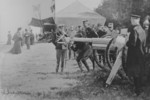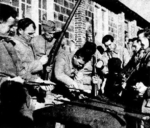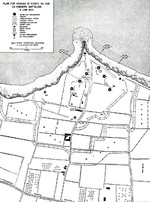
France
| Full Name | 10 French Republic | |
| Alliance | Allies - Minor Member Nation or Possession | |
| Entry into WW2 | 3 Sep 1939 | |
| Population in 1939 | 41,700,000 | |
| Military Deaths in WW2 | 212,000 | |
| Civilian Deaths in WW2 | 260,000 | |
| - Civ Deaths from Holocaust | 100,000 |
Contributor: C. Peter Chen
ww2dbaseWith 1.4 million people dead and countless acres of land lay in ruins at the end of World War I, France suffered dearly. When she eventually emerged victorious, she sought revenge on Germany after the eventual victory. In addition to placing an immense reparation on Germany, France also occupied the industrious Saarland, dictated Rhineland as a military-free buffer zone, and successfully argued for limiting German military in the post-WW1 era. What the French leaders, along with many contemporary leaders of other European nations, did not realize was that by placing Germany in such a shameful position, they were brewing for the next major conflict instead of ending the current one.
ww2dbaseTo prevent Germany from easily invading again, France established an elaborate system of defenses along the Rhine river christened the Maginot Line after Minister of Defense André Maginot. At the cost of 3 billion French Francs, the series of strong points, anti-tank obstacles, cement positions for machine gunners and grenadiers, heavy artillery positions, and other defense structures connected by tunnels and railroads made the eastern border "impenetrable". At least so the French believed. With such a strong defense, the French Army could easily hold any German invasion in the future, and use the line as a pivot for a counter offensive.
ww2dbasePolitically, France made intricate moves in the diplomatic arena. By entering in mutual defense pacts with Poland and Czechoslovakia, the French leaders thought they had Germany surrounded.
ww2dbaseThe plans did not turn out so well for France. Czechoslovakia fell as European leaders, including those in Paris, appeased Adolf Hitler by doing nothing. When Germany invaded Poland, the French debated for days before enacting the mutual defense pact, but even then they failed to attack Germany when the Germany military was preoccupied in the east. The final test came in May 1940 when Germany finally turned her military might on France, and the Maginot Line failed. French military leaders failed to prepare for modern warfare involving fast moving armor and aircraft, while having the bulk of the French Army pinned down at the Maginot Line made effective reaction with the main Germany attack through Belgium impossible. On 24 Jun 1940, France surrendered. The Vichy-French government was formed and cooperated with the Germans until its end, fighting against Allied forces particularly early in the war in battles at Mers-el-Kébir and Dakar.
ww2dbaseThat was not to say that the French people as a whole collaborated with Nazi Germany, however. The small number of those fled out of the country formed Free French forces that eventually all came under the command of Charles de Gaulle, fighting in several major campaigns. Many remained in France, too, fought the Germans by forming cells of saboteurs that were collectively as the French Resistance.
ww2dbaseThe liberation of France began in Jun 1944 when the Allied cross-channel invasion of Normandy commenced. General Philippe Leclerc entered Paris on 25 Aug 1944, dramatically boosting the morale of Frenchmen in the resistance against the German occupation.
ww2dbaseWhen the European War ended, France once again demanded a large reparation for lives lost, infrastructure damaged in battles, and industrial capacity pillaged by Nazi Germany.
ww2dbaseSource: Wikipedia.
Last Major Update: Apr 2007
| Events Taken Place in France | ||
| The Treaty of Versailles | 28 Jun 1919 | |
| Hoare-Laval Pact | 10 Dec 1935 | |
| Churchill's Tour of the Maginot Line | 16 Aug 1939 | |
| Invasion of France and the Low Countries | 10 May 1940 - 22 Jun 1940 | |
| The French Resistance | 22 Jun 1940 - 28 Aug 1944 | |
| Bombing of Cities in France and Low Countries | 1 Jul 1940 - 7 May 1945 | |
| Meeting at Hendaye | 23 Oct 1940 | |
| Raid on Saint-Nazaire | 28 Mar 1942 | |
| Attack on Dieppe | 18 Aug 1942 - 19 Aug 1942 | |
| Scuttling of the French Fleet | 27 Nov 1942 | |
| Normandy Campaign, Phase 1 | 6 Jun 1944 - 24 Jul 1944 | |
| V-Weapons Campaign | 13 Jun 1944 - 30 Mar 1945 | |
| Discovery of Concentration Camps and the Holocaust | 24 Jul 1944 - 29 Apr 1945 | |
| Normandy Campaign, Phase 2 | 25 Jul 1944 - 22 Aug 1944 | |
| Brittany Campaign | 1 Aug 1944 - 11 May 1945 | |
| Operation Aphrodite and Operation Anvil | 4 Aug 1944 - 1 Jan 1945 | |
| Invasion of Southern France | 15 Aug 1944 - 15 Sep 1944 | |
| Liberation of Paris | 25 Aug 1944 | |
| Battle of the Bulge | 16 Dec 1944 - 28 Jan 1945 | |
| Advance to the Rhine | 20 Jan 1945 - 25 Mar 1945 | |
| Paris Peace Conference | 29 Jul 1946 - 15 Oct 1946 | |
| Aircraft | ||||
| 130 | Bre.521 Bizerte | GL-812 HY | MB.150 | Potez 630 |
| 143 | D.500 | GL-832 HY | MB.200 | |
| 351/354 | D.520 | Latécoère 298 | MB.210 | |
| Bre.19 | F.220 | LeO 451 | MS.406 | |
| Vehicles | ||
| 37L | Canon de 194 modèle GPF | Panhard Type 178 |
| AMC 35 S | Char B1 | R35 |
| AMC 35 | Char D1 | UE |
| AMR 33 | FT-17 | |
| AMR 35 | H35 | |
| Territories, Possessions, and Nations Under the Influence of France | ||
| Algeria | French Morocco | Madagascar |
| French Antilles | French Polynesia | New Caledonia |
| French Cameroun | French Somaliland | Tunisia |
| French Equatorial Africa | French Syria and Lebanon | |
| French Indochina | French West Africa | |
| Facilities | ||
| Arsenal de Brest | Shipyard, Navy Base | |
| Drancy Concentration Camp | Prison Camp | |
| Fresnes Prison | Prison Camp | |
| La Coupole | Other | |
| Maginot Line | Fortification | |
| Merville Gun Battery | Fortification | |
| Toulon Military Port | Navy Base | |
Weather
WW2-Era Weather Data for France
Photographs
 |  |  |  |
 |  |  |  |